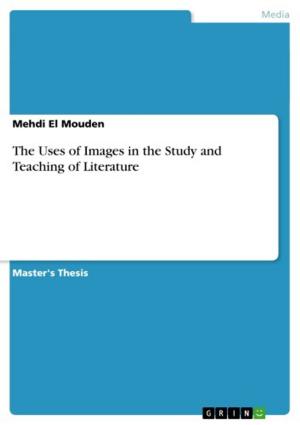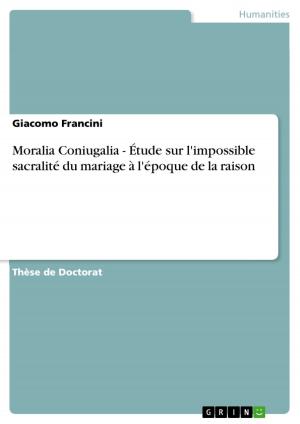From Strange Bedfellows to Soulmates: Psychoanalysis as an Allegory of Weimar Cinema
Fiction & Literature, Anthologies| Author: | Irene Fowlkes | ISBN: | 9783640312221 |
| Publisher: | GRIN Publishing | Publication: | April 23, 2009 |
| Imprint: | GRIN Publishing | Language: | English |
| Author: | Irene Fowlkes |
| ISBN: | 9783640312221 |
| Publisher: | GRIN Publishing |
| Publication: | April 23, 2009 |
| Imprint: | GRIN Publishing |
| Language: | English |
Essay from the year 2005 in the subject English Language and Literature Studies - Comparative Literature, grade: A, University of Paderborn, language: English, abstract: application of the science of psychology to the study of culture. The screening of the movie Secrets of a Soul on the birthday of the founding father of psychoanalysis Sigmund Freud in Berlin demonstrated the initial point of convergence between one of the most important and influential psychological theories of the 20th century and film production. Although Freud did not consider the cinematic medium as appropriate to fully explain the abstract concepts of psychoanalysis, which the film attempts by means of a case study concerning a patient's treatment, there apparently occurred some sort of transference process between the analyst and the artists. Thus, by mutually reinforcing each other, both discourses gained legitimacy making it worthwhile to further examine this relationship. G.W. Pabst's 1926 film, Secrets of a Soul (Geheimnisse einer Seele), is one such encounter, a chapter in the still unwritten and untheorized metahistory of psychoanalysis and cinema. This paper aims to make a contribution to that metahistorical text, proposing a combination of abstract analytical thought and popular entertainment during the Weimar Cinema period. In agreement with the notion, that 'the ready appeal of cinema as an analogy for mental processes brings about the danger of the loss of the specificity of psychoanalytic understanding'3, I will not try to equate the two discourses, but rather follow two objectives: First, utilize psychoanalytic theory as an instrument for strategic interpretation of the story / plot of a particular film and second, attempt to crystallize out the way it corresponds with cinematic representation. In regards to the latter aspect I operate under the assumption, that the creative process of film making entails a big part of the unconscious and thus lends itself to psychoanalytic interpretation. Although in contrast to Secrets of a Soul it does not deal with the method of psychoanalysis directly, I chose the movie The Cabinet of Dr Caligari for this paper, because I suppose that it contains various elements of the conceptual framework of the theory which comes about in narrative and visual terms. Primarily leaning onto a core text in the history of German film, written by the Marxian representative Krakauer, I will thus treat the movie as an allegory of psychoanalysis in general and try to see to what extent it can be considered a reflection of the so called collective unconscious. [...]
Essay from the year 2005 in the subject English Language and Literature Studies - Comparative Literature, grade: A, University of Paderborn, language: English, abstract: application of the science of psychology to the study of culture. The screening of the movie Secrets of a Soul on the birthday of the founding father of psychoanalysis Sigmund Freud in Berlin demonstrated the initial point of convergence between one of the most important and influential psychological theories of the 20th century and film production. Although Freud did not consider the cinematic medium as appropriate to fully explain the abstract concepts of psychoanalysis, which the film attempts by means of a case study concerning a patient's treatment, there apparently occurred some sort of transference process between the analyst and the artists. Thus, by mutually reinforcing each other, both discourses gained legitimacy making it worthwhile to further examine this relationship. G.W. Pabst's 1926 film, Secrets of a Soul (Geheimnisse einer Seele), is one such encounter, a chapter in the still unwritten and untheorized metahistory of psychoanalysis and cinema. This paper aims to make a contribution to that metahistorical text, proposing a combination of abstract analytical thought and popular entertainment during the Weimar Cinema period. In agreement with the notion, that 'the ready appeal of cinema as an analogy for mental processes brings about the danger of the loss of the specificity of psychoanalytic understanding'3, I will not try to equate the two discourses, but rather follow two objectives: First, utilize psychoanalytic theory as an instrument for strategic interpretation of the story / plot of a particular film and second, attempt to crystallize out the way it corresponds with cinematic representation. In regards to the latter aspect I operate under the assumption, that the creative process of film making entails a big part of the unconscious and thus lends itself to psychoanalytic interpretation. Although in contrast to Secrets of a Soul it does not deal with the method of psychoanalysis directly, I chose the movie The Cabinet of Dr Caligari for this paper, because I suppose that it contains various elements of the conceptual framework of the theory which comes about in narrative and visual terms. Primarily leaning onto a core text in the history of German film, written by the Marxian representative Krakauer, I will thus treat the movie as an allegory of psychoanalysis in general and try to see to what extent it can be considered a reflection of the so called collective unconscious. [...]















